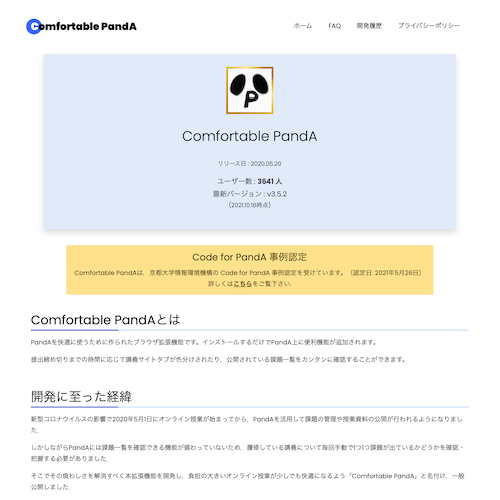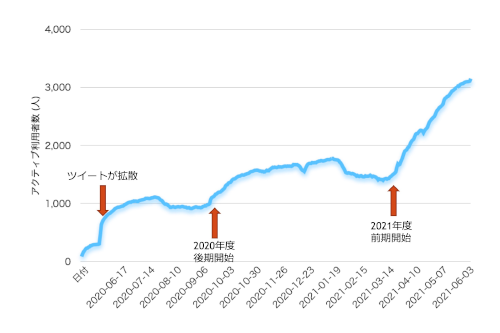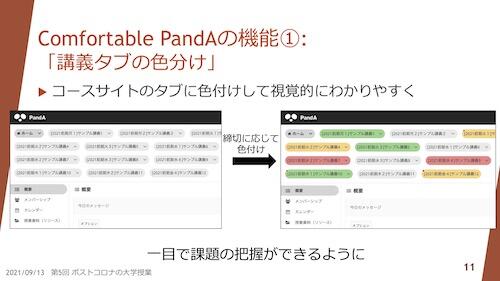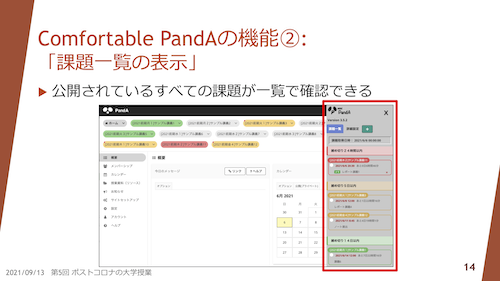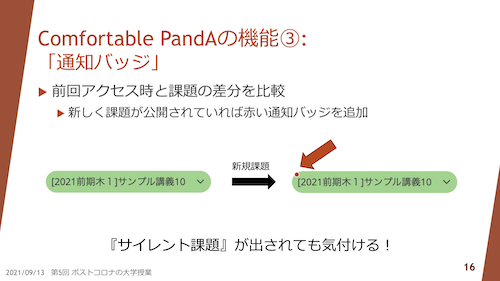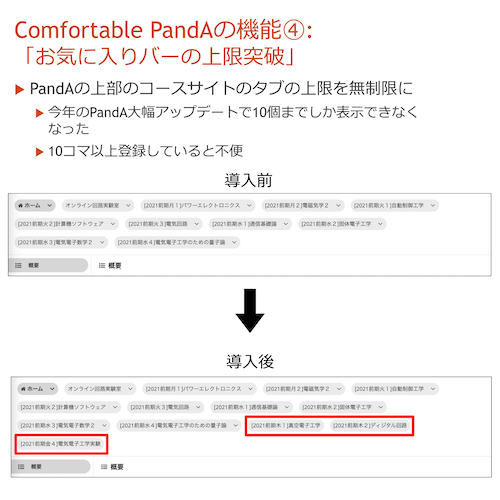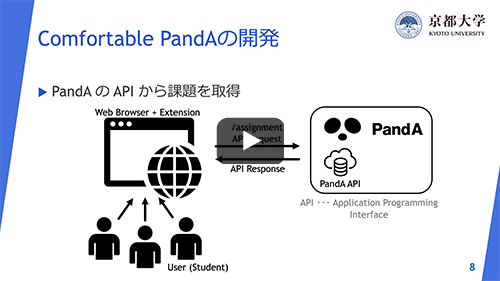TopicsStudents Interview
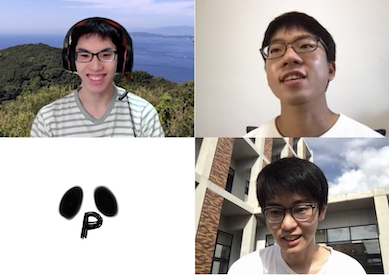
Student-initiated LMS Improvement Project: Going Glocal with "Comfortable PandA"
Mr. Kazuki Takeda, Mr. Chinamu Kawano, and Mr. Hiroaki Endo, Third-year students of the School of Electrical and Electronic Engineering in the Faculty of Engineering, Kyoto University
"Comfortable PandA" is an extension (plug-in) for web browsers. It was developed voluntarily by three students from the Faculty of Engineering, Kyoto University, with the aim of making "PandA" (Kyoto University's Learning Management System (LMS)) more intuitive and easier to use. They developed the extension and released it in May 2020 when online classes were in full swing. As of September 2021, when this interview was conducted, a total of 3,500 students, or a quarter of the undergraduate students at Kyoto University, were using the system.
We interviewed the developers of Comfortable PandA, Kazuki Takeda, Chinamu Kawano, and Hiroaki Endo, all third-year students of the School of Electrical and Electronic Engineering in the Faculty of Engineering (at the time of the interview), about the stories behind the development of Comfortable PandA, its functions, and future prospects.
Comfortable PandA used by a quarter of the undergraduate student population
Thank you for taking time out of your busy schedule before the second semester begins. Can you start by telling us about the relationship between the three of you?
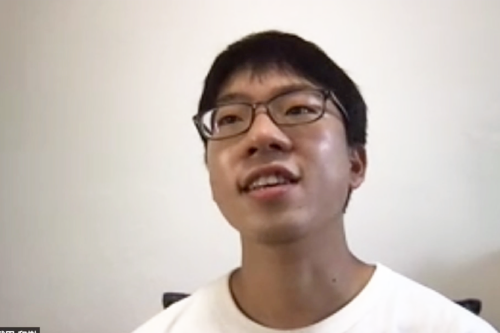
Mr. Kazuki Takeda, a third-year student in the School of Electrical and Electronic Engineering in the Faculty of Engineering
Takeda: We were in the same class when we were first-year undergraduates, and that's how we met. We found out that programming was our common interest, and since then, we have been working together on programming.
What inspired you to develop Comfortable PandA?
Takeda: In April 2020 when the first semester of our second year started, we were notified that classes would be held online, so we explored what we could do with PandA. Honestly, we felt that the platform left room for improvement to be more user-friendly with minor changes, and we anticipated that we could make it happen on our own. That's how we started the development of Comfortable PandA in the middle of May, completed it in about five days, and released it.
It was developed at a very fast pace. What was the response from users like?
The number of undergraduates at Kyoto University is roughly 13,000, so a simple calculation indicates that about one out of every four undergraduates uses the system. Isn't that amazing?
Collaborating by sharing skills and developing spontaneously
Could you show us the main features of Comfortable PandA?
Takeda: There are four major features. The first is the color-coding function for the course tabs at the top of the PandA screen. Originally, the tabs were white, but now they are color-coded in three different colors according to the time remaining until the due date of each course assignment.
Green is within 14 days, yellow is within 5 days, and red is within 24 hours, making the colors intuitive and easy to understand, just like traffic lights.
The second feature is the list of assignments with due dates for each course. A three-line icon appears on the right side of the menu bar at the top of the screen. By clicking on the icon, you can see a list of all the assignments that are currently due.
This feature also allows users to sort assignments by the due date, check the ones that have been submitted, and add assignments that are not available on PandA.
The third feature is the assignment notification badge. The user is notified with a red badge displayed in the course tab if a new assignment has been posted since their last access to the site.
There is some sort of communication issue with PandA regarding assignment notifications. For example, newly posted assignments are barely identifiable on PandA's course site. Despite the "notification" option available on the instructor's side, it all depends on the instructor whether to use the function to notify students when a new assignment is posted to PandA. If the instructor gives assignments during class in a mumbling tone, they can be easily missed.
These are what we call "silent assignments" - miscommunicated assignments between the instructor and students. With the assignment notification badge feature of Comfortable PandA, students will not miss these silent assignments.
Last but not least, the "Push the Favorites Bar Limits" function was added following the major upgrade of PandA in March 2021. As a result of the major upgrade, the number of course tabs displayed in the favorites bar is now limited to 10.
From the instructor's point of view, 10 course tabs in the favorites bar may be enough, but this limitation is very inconvenient for students who are taking more than 10 courses. To overcome the inconvenience experienced by student users, we came up with the "Push the Favorites Bar Limits" function, which allows students to add as many favorites as they want.
Other features include a "cache function" that retrieves data from PandA every few minutes; and a "color universal function" that allows users to change the aforementioned green, yellow, and red colors as they wish. These functions are compatible with four major browsers: Google Chrome, Firefox, Microsoft Edge, and Safari.
The features described so far were presented at the Cyber Symposium hosted by the National Institute of Informatics (NII) in June 2021. My presentation slides on Comfortable PandA (only in Japanese) are available for your review. Also, check out my presentation from the workshop hosted by the Center for the Promotion of Excellence in Higher Education on September 13, 2021, if you are interested.
*His presentation video and slides from the workshop can be viewed here (KU members only).
You've been upgrading functions to better meet the needs of student users. What roles does each of you play in the team?
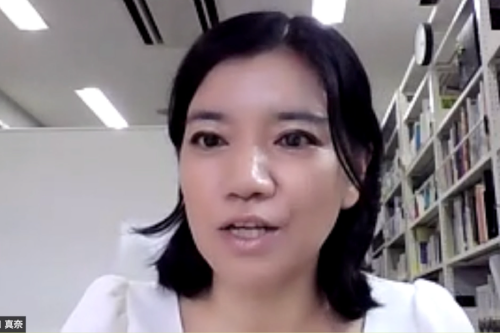
Interviewer: Dr. Mana Taguchi, Associate Professor, Center for the Promotion of Excellence in Higher Education
Takeda: We don't have a specific assigned role. Rather, we develop Comfortable PandA together through online discussions. Originally, I was the only developer, but Mr. Kawano and Mr. Endo started helping me along the way.
The "Push the Favorites Bar Limits" function I mentioned earlier was developed and implemented by Mr. Kawano, and the color universal function by Mr. Endo.How did you come up with the "Push the Limits" function?
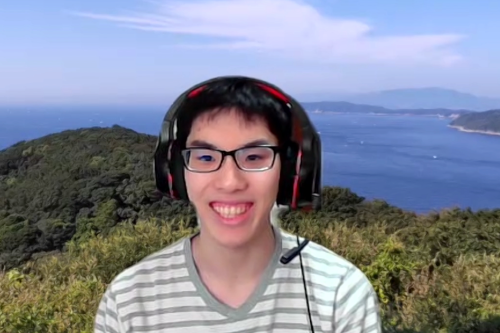
Mr. Chinamu Kawano, a third-year student in the School of Electrical and Electronic Engineering in the Faculty of Engineering
Takeda: I was not satisfied with the limitation, and I wanted to get rid of it somehow. However, I knew it was difficult to do so with my skills alone, so I asked Mr. Kawano for advice, and eventually, he developed the "Push the Limits" function for Comfortable PandA.
Kawano: I, too, felt that it was inconvenient to have only up to 10 course tabs saved in the favorites bar, so I was thinking of making an extension separate from Comfortable PandA. Coincidentally, Mr. Takeda told me that he wanted to add such a function to Comfortable PandA. In the end, I decided to develop a new function for Comfortable PandA rather than creating a separate one.
Takeda: Mr. Kawano also helped me when I rewrote the source code of Comfortable PandA in December last year.
Kawano: It was originally written in JavaScript, but for the convenience of future maintenance, we agreed to rewrite the source code in a language called Typescript.
Mr. Endo, what inspired you to develop the "color universal" function?
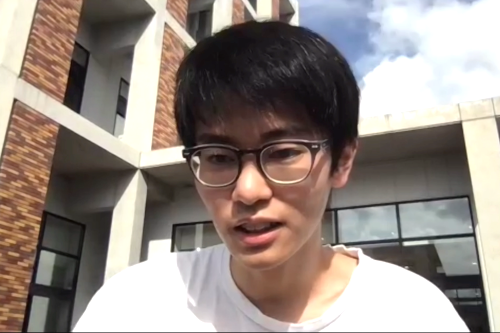
Mr. Hiroaki Endo, a third-year student in the School of Electrical and Electronic Engineering in the Faculty of Engineering
Endo: I have a friend who can't see red out of the three primary colors of light: red, green, and blue (RGB). He once told me that he could not see the color code of resistors in electronic components, so I developed this "color universal" function in the hope of making the system visible to such colorblind users.
I am so impressed with everyone's voluntary and proactive engagement.
Collaboration with Kyoto University: Improved functionality of PandA to the global LMS "Sakai"
At the workshop held in September, you mentioned during your presentation that you like PandA. Could you elaborate on that?
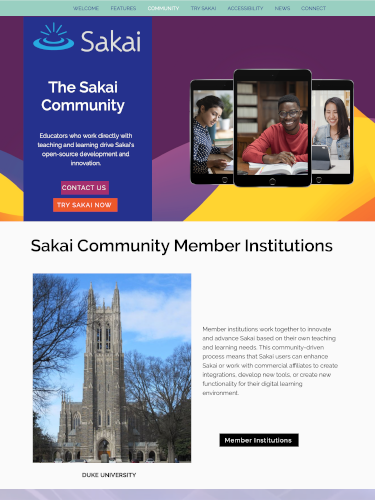
LMS Sakai's Website
Takeda: That's right. First, my interest in PandA was sparked when I learned that PandA was based on "Sakai," an internationally recognized LMS developed in the United States. It really struck me that a Japanese university was using a unique system from overseas.
Driven by curiosity, I did some research and found out that PandA is designed with a REST (REpresentational State Transfer) API (Application Programming Interface), which is an interface for external access. The API allows us to link PandA's data to our system and add new functions. All in all, this interface gave me the impetus to develop Comfortable PandA.
Without an API, it would have been impossible to create Comfortable PandA in the first place. I am very happy that Kyoto University has designed PandA with such a system. I don't think there are many other universities that can do the same.
I heard that you are currently collaborating with Prof. Masashi Kajita of the Institute for Information Management and Communication on the management of PandA.
Takeda: Indeed. Prof. Kajita contacted us and recommended that we should apply for "Code for PandA Case Study," which certifies ongoing software development efforts to improve the overall functionality of PandA. Thereafter, Comfortable PandA was officially certified in May 2021.
When Prof. Kajita first contacted us, we were afraid that he would be mad at us for creating Comfortable PandA as an "uncertified" extension. However, that worry was dispelled when he expressed strong interest and excitement in Comfortable PandA. He seemed to be proud of us, the students taking the initiative in the project.
Since the "certification" of Comfortable PandA, we have been closely collaborating with Prof. Kajita. We are currently working on the development of "Comfortable Sakai," which will apply the system of Comfortable PandA to Sakai, the LMS from which PandA originated. The results of this work will be presented at an international conference on Sakai.
You mentioned earlier that you gave a presentation at the NII Cyber Symposium. Will the three of you continue to manage Comfortable PandA in the future?
Presentation video from NII Cyber Symposium
Click herefor details (The 35th NII Educational Institutions DX Symposium (June 25, 2021, only in Japanese))
Takeda: In the meantime, we plan to continue the management, but we may not be able to fully handle it after we proceed to graduate school. With this in mind, we are currently discussing the possibility of integrating the functions of Comfortable PandA into PandA itself at some point and having it managed and maintained by the Institute for Information Management and Communication.
I see. If it is managed by the Institute for Information Management and Communication, the name "Comfortable PandA" may not remain. Is that OK with you?
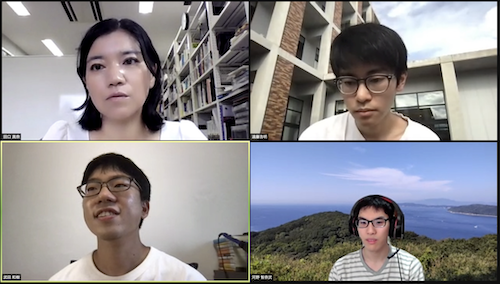
Takeda: We would rather be very happy if that happens for real. The integration means PandA will already be a comfortable service for users, doesn't it?
Kawano: I would also be happy if Comfortable PandA were merged to its parent.
Endo: Same here. The original purpose of this project was to make PandA itself more user-friendly so that we could work on assignments without missing anything important.
I am deeply touched by the enthusiasm and engagement you three have exhibited.
Inviting student voices to improve the university system / Let good educational practices flourish in the "post-COVID-19 era."
What stands out this project from others is that it is "student-initiated." Is there anything else you are thinking about to improve the university system from students' perspectives?
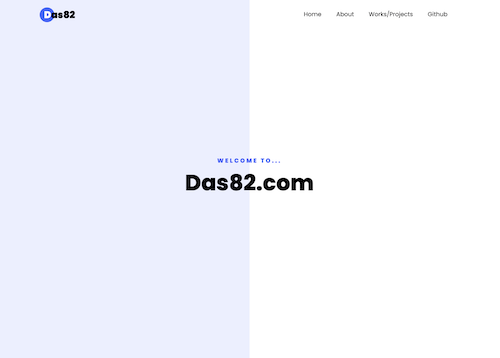
Mr. Takeda's website: Das82.com, where he releases the tools that he has been developing, including Comfortable PandA.
Kawano: I think there are many students who want to improve multitudes of systems of the university. It would be ideal if students could be part of the improvement. For example, as mentioned earlier, if APIs are readily accessible, I think those students who are familiar with programming would voluntarily try to improve some university systems. Unfortunately, however, there are no systems other than PandA that have APIs set up. It would be more convenient if APIs were made available to the extent possible.
Takeda: Student participation would be more encouraged if each service, including APIs, had a terms and conditions of use, such as "you may use or improve the service without permission under such and such conditions." When we released Comfortable PandA, we looked for such terms of use, only to find that there were none. We had no choice but to release it as an "uncertified" application.
One professor proposed a system that invites ideas from students, something like a competition. I think it would motivate students to participate and improve the university system in many ways.
A competition to solicit ideas from students sounds very appealing. Do you have any other suggestions or recommendations about classes and education at Kyoto University?
Kawano: I would like to see some of the good online educational practices introduced during the COVID-19 pandemic continue even in the post-COVID-19 era. For example, distributing resumes and informing assignments online.
Endo: What I like about online classes is that they can be video-recorded and shared afterward. I was able to review what I had learned in class by watching the videos again. I want the tradition of sharing class videos to continue, and I hope that teachers who are conducting online classes but not sharing their videos will positively consider doing so as well. This is not because we want to skip class, but because we truly want to gain a deeper understanding of what we learn.
Takeda: In the online classes I took, several teachers were proactively seeking ways to integrate ICT in their teaching, such as displaying students' comments on the screen during class and using YouTube Live. I do hope that these efforts and innovative approaches keep on growing even after the COVID-19 pandemic.
Thank you very much for your time.
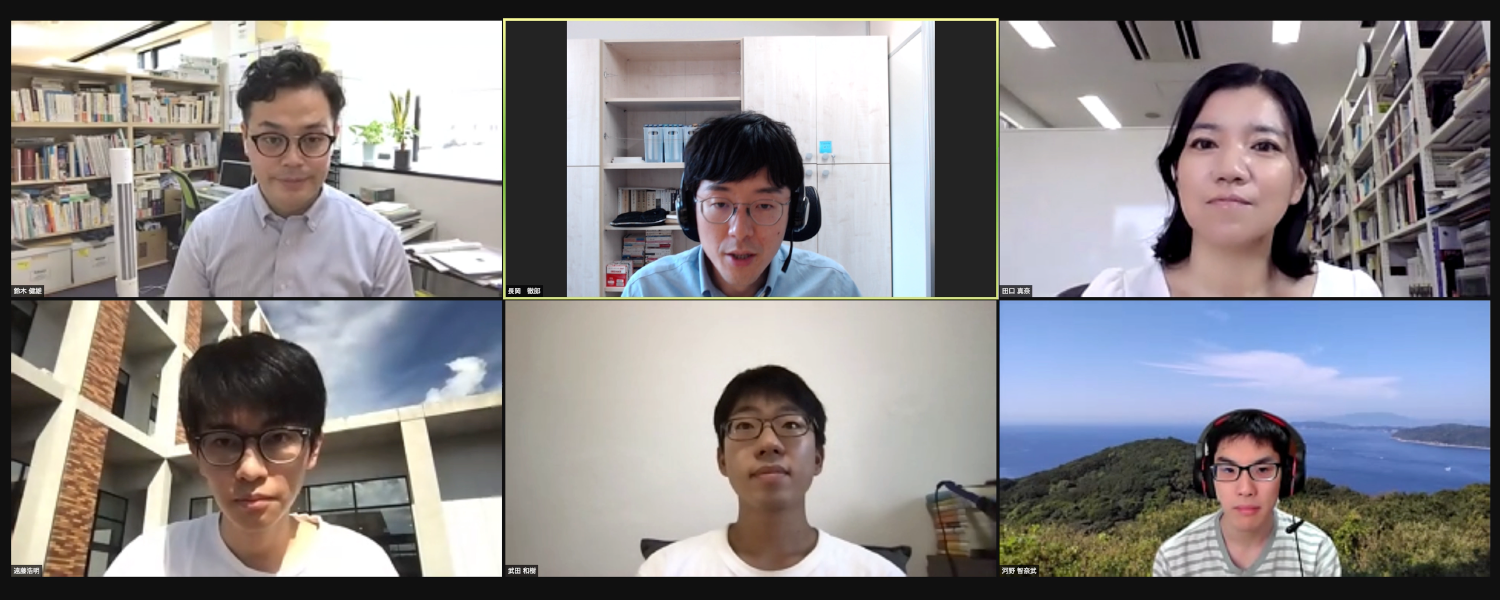
The participants of the interview. Clockwise from the upper left: Mr. Takeo Suzuki, Program-Specific Researcher, and Mr. Tetsuro Nagaoka, Research Associate, Center for the Promotion of Excellence in Higher Education; Associate Professor Taguchi; Mr. Kawano; Mr. Takeda; and Mr. Endo.
(Interviewer: Mana Taguchi/ Text: Takeo Suzuki/ Photography: Tetsuro Nagaoka/ Interview date: September 24, 2021 / Publication date of this article: May 10, 2022)

